
Related
Guests
- Joe Picurroformer freelance ironworker. He worked at Ground Zero after 9/11 and is suffering from terminal lung disease. He is forty-two years old.
- Rep. Carolyn Maloney (D - New York)co-sponsor of the 9/11 Health and Compensation Act.
- Dr. Jacqueline Molinedirector of the World Trade Center Medical Monitoring and Treatment Program at the Mount Sinai School of Medicine.
Today marks the eighth anniversary of 9/11, with vigils being held to remember the nearly 3,000 people killed in the attacks. We look at a group of victims that are often forgotten in the September 11 narrative: the thousands of rescue workers who became sick after being exposed to contaminants at Ground Zero. Hundreds have died. We speak to Joe Picurro, a New Jersey ironworker who worked as a volunteer on the pile for twenty-eight days. He is now dying of lung disease. We also speak with Rep. Carolyn Maloney (D-NY), who is co-sponsoring the 9/11 Health and Compensation Act, and Dr. Jacqueline Moline, director of the World Trade Center Medical Monitoring and Treatment Program at the Mount Sinai School of Medicine. [includes rush transcript]
Transcript
JUAN GONZALEZ: Vigils will be held today at the World Trade Center, the Pentagon and in Pennsylvania to remember the nearly 3,000 people killed eight years ago in the September 11th attacks. In New York, moments of silence will be observed at Ground Zero to mark the time when the hijacked planes hit the World Trade Center and to mark when the towers fell. A reading of the victims’ names will also be held at Ground Zero.
Today on Democracy Now! we look at a group of victims that are often forgotten in the September 11th narrative: the many rescue workers who have since become sick after being exposed to contaminants at Ground Zero. In a few minutes we’ll be joined by Congresswoman Carolyn Maloney of New York. She’s the sponsor of the 9/11 Health and Compensation Act, which would provide permanent health treatment and compensation for all 9/11 Ground Zero workers and residents who become sick from their exposures to contaminants. But first, we want to turn to the story of Joe Picurro, an iron worker from New Jersey.
AMY GOODMAN: Joe Picurro was one of thousands of men and women who showed up at Ground Zero on September 11th to help with the rescue and recovery efforts. He was thirty-four years old at the time.
Now Joe is dying. His doctor has told him he has the lungs of a ninety-five-year-old. His lungs are so inflamed from all the tiny particles of glass and even human bone fragments lodged in them that every breath produces excruciating pain. He’s been unable to work for the last five years and takes thirty-seven different medicines.
Juan, you wrote about Joe Picurro in this week’s New York Daily News column that was called “Time to Rescue Our 9/11 Heroes Ill from Ground Zero Cleanup.” Joe is joining us now from New Jersey. Juan?
JUAN GONZALEZ: Yes. And Joe, tell us some of the story, first how you got to Ground Zero and then what were the effects, how long it took for you to realize how sick you were.
JOE PICURRO: Well, I left for —- around midnight I left my house. And, you know, I watched like everybody else; on the TV, I watched the towers go down. And I have policemen and firemen in my family, and I knew the kind of equipment they carried, and I knew they didn’t have the kind of equipment to cut that steel. So I grabbed some of my tools, and I jumped in my car, and I went up there. You know, I walked into -—
JUAN GONZALEZ: And you lived in Toms River, New Jersey, right? That’s about, what, sixty miles from New York?
JOE PICURRO: Yeah, about sixty-five, sixty, sixty-eight miles, something like that.
And I threw my — like I said, I threw my tools in, and I walked into — you know, into hell. And just surreal. I never seen anything like it. There was —- you know, I was literally tripping over body parts. You know, we were putting them in five-gallon buckets for the first couple hours I was there. And, you know, it was bad.
And I stayed there twenty-eight days. I stayed there fourteen days total at first, and then I came home for eight days, and I went back for another fourteen days. The first couple of days I slept on the floor of the American Express building, because they didn’t have anywhere else for us to sleep, that I knew about, anyway. And so, I slept in the dust and the glass in the American Express building, when I could. And that’s -—
AMY GOODMAN: Joe, you started coughing the first day?
JOE PICURRO: Pretty much, yeah. I mean, within minutes you got down there, you started coughing. All the air was filled with dust, though, and, you know, every time you moved, you kicked up dust. I mean, it was knee deep in some spots, you know. It was pretty surreal. You know, you couldn’t see what you were stepping on, what you’re tripping over.
Part of the street fell in. Me and a bunch of firemen started running. They grabbed me and said, “Run!” And the street was falling in. And then I ran, and then I realized I was running alone. They were running back, so I turned around and went back with them.
AMY GOODMAN: Joe, tell us your condition today. This is the eighth anniversary of the 9/11 attacks. It’s actually just down the road from where we are now. We were the closest national broadcast to Ground Zero in this big old, hundred-year-old firehouse, that also our colleagues opened up for people just running down the road to give them water, to let them have access to the phone. Today, Joe, eight years later?
JOE PICURRO: Well, right now I’m hooked up to my oxygen machine. You know, my lungs are — I went to the doctor yesterday, and it was — we didn’t get good news. Basically, the doctor said, you know, if he could get me another year or two, you know, he would — you know, he’d be surprised. And so, I’m on thirty-seven medications — well, actually thirty-nine; he put me on two more, you know, when I went to see him yesterday.
And, you know, most of my problems come from my lungs, but my whole body is racked with pain, all my joints. It’s just like a laundry list of problems. If it’s not one thing, it’s another, you know? Breathing, like I said, is the hardest. Like I said, I’m hooked up to oxygen now. My lungs have concrete and glass and human bone fragments in them. And, you know, so what happens is your lungs are the only organ that rejuvenate themselves, and mine, instead of growing viable lung tissue, they’re growing — it’s growing scar tissue. So it’s making my lungs get bigger and bigger. And when I take a deep breath, my lungs actually rub against my ribs, and it hurts.
JUAN GONZALEZ: And you also have problems of constantly vomiting and also —- could you talk about the other problems that you’ve had?
JOE PICURRO: Yeah. Well, yeah, I go through these vomiting bouts, where my throat is torn up from the glass and the stuff I inhaled and also from throwing up. And it’s caused my teeth to rot from throwing up, and the medicine that I’m on. I had to have a tooth pulled just last month. It’s, you know -—
AMY GOODMAN: Joe, I know you were supposed to be picked up by the Mayor this morning —-
JOE PICURRO: Yeah.
AMY GOODMAN: —- to go to 9/11 memorial, but you’re now too sick to go with him.
JOE PICURRO: Yeah.
AMY GOODMAN: What kind of compensation have you gotten over this last eight years?
JOE PICURRO: I get — we fought for — me and my wife fought for four years, I think, almost four years, just to get workman’s comp, which was originally started at 125 every two weeks, $125 every two weeks, and then we went back into court, and I got it bumped up to $250 every two weeks. So I get a total of $500 — [coughing] — excuse me. I get a total of $500 a month from New York as compensation.
AMY GOODMAN: How much does your medication cost you?
JOE PICURRO: It doesn’t cost me anything, thank God. They send — they do pay for my medication. It comes from IWP, Injured Workers Pharmacy, and it comes through the mail. Matter of fact, I’m waiting for a delivery this morning. Some of my pain medication and some of my new breathing medication is coming this morning.
AMY GOODMAN: Joe, we’re going to break, and then we’re going to come back to this discussion. For sixty seconds, we’ll break. Joe Picurro, former freelance ironworker, worked at Ground Zero, starting 9/11. He just raced from New Jersey to what’s known as “the pile,” just down the road from here, known as “Hoboken Joe,” the ironworker. And he slept on the floor of the AmEx building and others for two weeks, as he tried to help here at the site of the attacks. This is Democracy Now! Back in a minute.
[break]
AMY GOODMAN: We bring into the conversation with Joe Picurro, the freelance ironworker who came to Ground Zero on 9/11 and stayed for weeks, two other guests. Democratic Congresswoman Carolyn Maloney joins us here in the firehouse, co-sponsor of the 9/11 Health and Compensation Act. And we’re joined by Dr. Jacqueline Moline, director of the World Trade Center Medical Monitoring and Treatment Program at the Mount Sinai School of Medicine.
Carolyn Maloney, you have introduced legislation that does what?
REP. CAROLYN MALONEY: Well, I’ve introduced legislation for seven years. We know that on 9/11 almost 3,000 people died, but thousands more lost their health, like Joe. And it has been progressive, and there has not been the support and help for them. Along with a New York delegation, we have secured funding for special programs, such as the Mount Sinai program and the Bellevue program and other programs. Centers for Excellence, we call them. But it’s a fight every year. We need a long-term program to help people like Joe.
And we remember those days. I remember the signs, looking missing — looking for people that were missing. But there were more signs for ironworkers than anything else. “Ironworkers, report to duty.” “Retired ironworkers, where are you?” “Ironworkers, come, help, help, help.” Well, many came, like Joe. They were not paid. Many were volunteers. People came from all over the country. It’s just not New York workers, but New Jersey. I did a study. Out of the 435 congressional seats, 432 congressional seats sent workers, volunteers, to work at Ground Zero.
And the bill would cover monitoring for everyone who was exposed to the deadly toxins. It wasn’t air; it was like Juan described it: it was soup. You could literally eat it. It was thick. So, everyone who was exposed, and treatment for everyone who was sick. And it reopens the Victims Compensation Board. The Victims Compensation Board helped the families, the innocent families, and victims and the firefighters and officers and police and volunteers who died that day. But in a sense, those who made a decision to walk into the flames, they made just as much of a sacrifice, and many, many, many are sick and dying, like Joe.
JUAN GONZALEZ: Well, I want to play a short excerpt from a 2007 congressional hearing when the former head of the Environmental Protection Agency, Christie Todd Whitman, denied misleading the public over environmental dangers after 9/11. Whitman and John Henshaw, the former head of the Occupational Safety and Health Administration, were questioned by Congressman Jerrold Nadler.
REP. JERROLD NADLER: In a series of EPA press releases beginning on September 13th, the following words were used to describe the air conditions: “good news,” “causes no concern,” “not detectable,” “no significant health risk” and “safe to breathe.” Ms. Whitman, do these words and phrases convey a sense of danger or even of caution? Or do they, in fact, convey a sense of safety and security?
CHRISTINE TODD WHITMAN: Mr. Chairman, those words, to the best of my recollection, in every effort that I made at the time, were also added with the phrase, “however, on the pile it is different.”
REP. JERROLD NADLER: Well, we’ll get to that.
CHRISTINE TODD WHITMAN: And that’s —- but there’s a significant difference. The readings we were getting of air quality at the time, general -—
REP. JERROLD NADLER: Excuse me. We will get to that. Please. We only have a few minutes. Answer my questions. Do they convey a sense of safety and security or a sense of caution?
CHRISTINE TODD WHITMAN: They should — they convey exactly what they were meant to convey.
REP. JERROLD NADLER: OK.
CHRISTINE TODD WHITMAN: Those were the readings we were getting from the scientists.
REP. JERROLD NADLER: Do you regret your repeated assurances the air was safe to breathe?
CHRISTINE TODD WHITMAN: I do not regret repeating what the scientists said was appropriate.
REP. JERROLD NADLER: OK. Mr. Henshaw, do these words and phrases convey a sense of danger or even of caution, or do they convey a sense of safety and security, in your opinion?
JOHN HENSHAW: Again, not counting the pile. The pile was as a separate circumstance.
REP. JERROLD NADLER: We’ll get to the pile.
JOHN HENSHAW: Alright. We sampled — we took 240 samples.
REP. JERROLD NADLER: I just asked — please, answer the question. We’ll get to all that.
JOHN HENSHAW: All of our samples were below or significantly below our permissible exposure limits.
REP. JERROLD NADLER: Excuse me. You said that already. It’s on the record. I just asked you if this conveyed a sense of safety.
JOHN HENSHAW: That conveys that the environment is safe.
REP. JERROLD NADLER: OK, thank you. Do you now regret saying it was safe for New Yorkers to go back to work six days after the terrorist attack? Was that a mistake?
JOHN HENSHAW: Not within the Financial District. On the pile was a different circumstance. Sir, I do not regret that.
REP. JERROLD NADLER: But in the area around it, it was OK?
JOHN HENSHAW: All of our data indicated that it was OK.
AMY GOODMAN: That was Henshaw, the head of Occupational Safety and Health Administration, being questioned by New York Congress member Jerrold Nadler. Before that, Christine Todd Whitman, who was the head of the EPA. Juan, you did a lot of the original exposé on the consequences of the World Trade Center collapse and wrote a book called Fallout, exposing Christine Todd Whitman.
JUAN GONZALEZ: Yes, and I’d like to ask Congresswoman Maloney now — obviously, it’s been years now, and Christie Todd Whitman is long gone, but the impact on the public and on the workers of these erroneous pronouncements by federal officials then?
REP. CAROLYN MALONEY: Oh, I think it cost lives. It cost — people are dying. They’re sick. Government should have provided more safety measures and more preventive measures. I was down on 9/12. There were no masks. People were just working in the debris. As Joe said, you could — it was almost like walking through snow. It was like something I’ve never seen. You would walk through this — it’s not mist. It was like walking through a soup up to your knees. And the air was very, very thick. And many, many are sick, and we don’t know the long-term impact, the cancers that may be there. That’s why the bill is for thirty years, to cover not only now, but other illnesses that may and will develop because of the exposure to these toxins.
AMY GOODMAN: Well, speaking of the cancers and the illness, we go now to Dr. Jacqueline Moline, director of the World Trade Center Medical Monitoring and Treatment Program at the Mount Sinai School of Medicine.
Dr. Moline, welcome to Democracy Now! Tell us what you have found, the number of people you have worked with, and your latest discoveries.
DR. JACQUELINE MOLINE: Well, in our consortium, our Centers of Excellence, we are following about 27,000 folks. We’ve seen them in for a monitoring exam and continue to follow them with annual exams. We’ve been doing this since 2002, thanks to Congresswoman Maloney and the leadership she has shown in getting the funds to these programs so that we can have these programs. And also we’ve been able to treat them with federal funds since 2006.
What we’re seeing are problems of the respiratory tract, of the upper respiratory tract, the lower respiratory tract, gastroesophageal reflux disease, post-traumatic stress disorder, anxiety, depression. These problems that began in 2001 continue to 2009 and will continue in the years to come.
What we’re also seeing is unusual patterns of disease presentation. We just recently published a paper that showed that —- we saw a group of younger workers at the site who developed a cancer of the immune system and multiple myeloma. And while it’s premature to be able to say that rates, in general, are elevated as a result of the exposures, what we’re seeing is an unusual age distribution. It’s a cancer usually we see in sixty— or seventy-year-old folks. And we saw four people under the age of forty-five. We’ve also seen other folks who are in the younger age category, much higher than we would expect. We would expect one person with cancer under forty-five in the size of the population that we’re following.
We’re on the alert for emerging diseases. We’re on the alert for disease patterns that are unusual. The severity of disease that some people are showing is unexpected. And that’s why it is so critical for us to have this long-term funding. It isn’t just something that happened in the first weeks and months, or even in the first few years. What we need to do is be able to follow the health of folks as we move into a period of time where any long-term diseases that might occur will start manifesting themselves.
JUAN GONZALEZ: And Dr. Moline, you are monitoring a total of about 28,000 people who worked on the pile?
DR. JACQUELINE MOLINE: Between Mount Sinai and our partners, we have seen almost 28,000 folks that have come through for a monitoring examination. An additional 15,000 individuals who work for the Fire Department are seen in their program. There are also some folks who are being treated who lived or worked in the environment.
JUAN GONZALEZ: And Joe Picurro, in the last few minutes that we have, your hope for what this legislation might be able to do for you and others like you who continue to suffer?
JOE PICURRO: Well, I hope it passes. I hope the bill passes. I’d like to say, first of all, to Ms. Maloney, Congresswoman Maloney, if there ever is a mold to make politicians, they should start with her. She is absolutely fantastic in her fight for us, has been, you know, unwavering. And also Dr. Moline, she’s met me before. I know who she is. And she has been fighting for us also, and I really appreciate it. I wanted to get that out.
But, you know, like Dr. Moline said, the different diseases, the gastro reflux and all that, I have all those things. And, you know, like my doctor said, I have the lungs of a ninety-five-year-old man. Now, you know, what she said about age, you know, we’re aging and our bodies are aging way before they’re supposed to. You know, and like I said, the doctor gave me a year or so to live, you know, and a year or two to live.
And, you know, that’s — you know, we need to get this straight. We need to straighten this out. We need to get the funding. We need to get the James Zadroga bill passed. You know, I mean, I’ve been saying this year after year — so has Ms. Maloney and also Ms. Moline — that it has to be passed. And yet, it never seems to make it. It never seems to get passed. And I don’t understand why. I don’t —-
I mean, we were there for them when they needed us. And, you know, they told us -— Christine Whitman stood there, and I don’t care what she says about it. She said the pile was different. She’s a liar. I was standing there. She did not say that the air was different on the pile. She stood on the pile with her mask below her neck and talked to us and told us we were heroes and said the air was fine, and she put the mask back on, and she got back in her car, and she left, you know, and went back to New Jersey where it was safe. So she’s a liar, and that’s all she is.
AMY GOODMAN: We’re going to have to leave it there. Joe Picurro, thanks so much for being with us. Joe, an ironworker at Ground Zero, stayed, oh, a total of about a month working here as a volunteer to try to help. Congress member Carolyn Maloney, Democratic Congress member from New York, co-sponsor of the 9/11 Health and Compensation Act, and Dr. Jacqueline Moline, director of the World Trade Center Medical Monitoring and Treatment Program at Mount Sinai School of Medicine.
This is Democracy Now!, democracynow.org, The War and Peace Report. As we broadcast this show, we are just minutes from the actual anniversary, eight years ago at this time, of the 9/11 attacks.

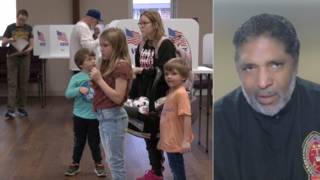

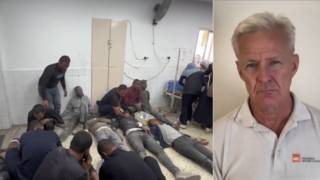
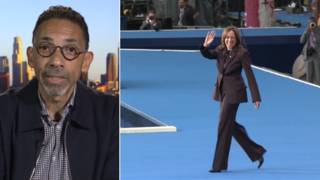





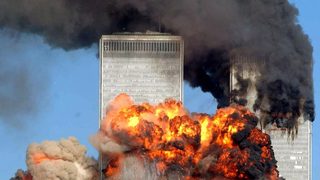

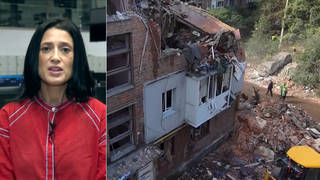
Media Options